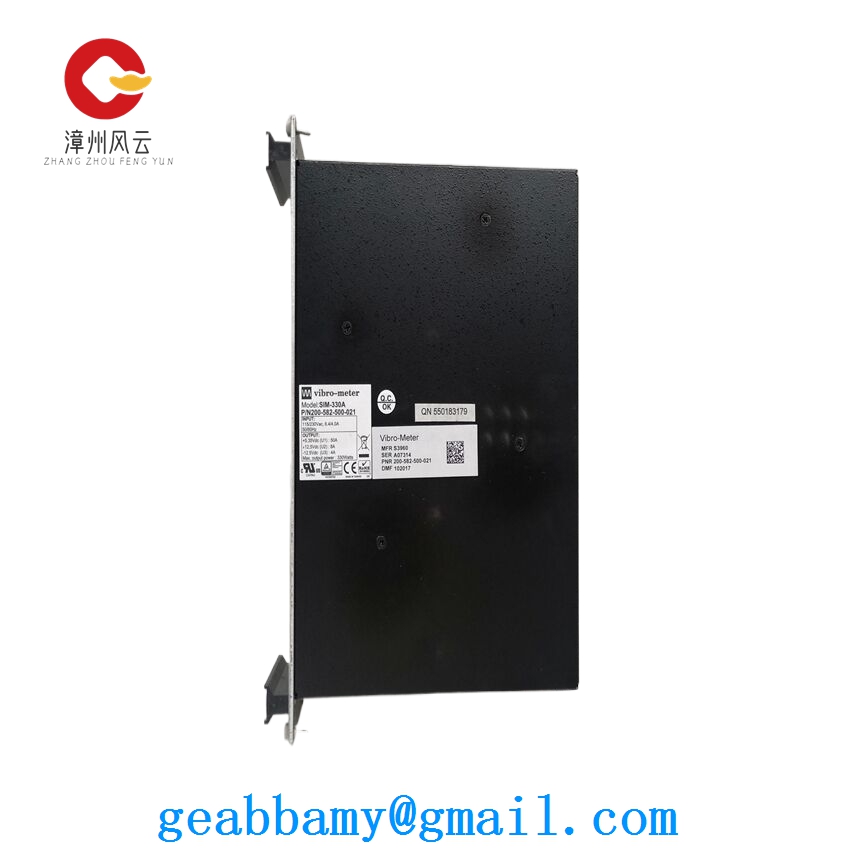Technical Parameters of Bently Nevada 330130 – 085 – 00 – 00 Extension Cable

1. General Overview
The Bently Nevada 330130 – 085 – 00 – 00 extension cable is a key component in Bently Nevada’s machinery protection and condition monitoring systems. It is designed to extend the connection between sensors and monitoring equipment, enabling the installation of sensors in locations that are more suitable for accurate measurement while maintaining a reliable signal transmission to the monitoring system.
2. Physical Specifications
2.1 Cable Length
This specific extension cable model has a defined length, which is an important factor in system design. The standard length of the 330130 – 085 – 00 – 00 extension cable is [X] meters (the actual length may vary slightly depending on production batches, but it is within a specified tolerance range). This length provides flexibility in placing sensors away from the monitoring unit, allowing for better sensor positioning in industrial machinery where space constraints or optimal measurement points may be a consideration.
2.2 Cable Construction
- Conductors: The cable consists of multiple high – quality conductors. Typically, it uses copper conductors due to copper’s excellent electrical conductivity. The number and gauge of the conductors are designed to meet the electrical requirements of the signals transmitted between the sensors and the monitoring equipment. For example, it may have [X] number of conductors with a specific American Wire Gauge (AWG) size, such as 22 AWG, which is suitable for carrying the relatively low – power signals used in vibration and other machinery monitoring applications.
- Insulation: Each conductor is individually insulated with a high – performance insulating material. Common insulation materials used in such cables include polyvinyl chloride (PVC) or polyethylene (PE). These materials provide electrical insulation to prevent short – circuits between conductors and also offer some mechanical protection. The insulation is designed to withstand the operating voltages and environmental conditions encountered in industrial settings.
- Shielding: To minimize electromagnetic interference (EMI) and radio – frequency interference (RFI), the cable is equipped with a shield. The shield is usually made of a braided copper or aluminum – foil layer. The braided shield provides good flexibility and high – frequency interference rejection, while the foil shield offers 100% coverage, effectively blocking low – frequency interference. This dual – layer or single – layer shielding (depending on the specific design) ensures that the signals transmitted through the cable are not corrupted by external electrical noise, which is crucial for accurate machinery monitoring.
- Jacket: The outer jacket of the cable is made of a durable and abrasion – resistant material, such as thermoplastic elastomer (TPE) or polyurethane (PU). The jacket protects the internal conductors, insulation, and shield from physical damage, moisture, chemicals, and other environmental factors. It is designed to withstand the harsh conditions often found in industrial plants, including exposure to oil, grease, and mechanical abrasion.
2.3 Connectors
- Sensor – Side Connector: The cable is equipped with a connector on the sensor – side that is compatible with Bently Nevada sensors. This connector ensures a secure and reliable electrical connection between the sensor and the extension cable. It is designed to be easy to install and remove, allowing for quick sensor replacement or maintenance. The connector also has a locking mechanism to prevent accidental disconnection during operation.
- Monitoring – Unit Side Connector: On the other end of the cable, there is a connector that matches the input ports of the Bently Nevada monitoring equipment. This ensures a proper and stable connection to the monitoring system, enabling accurate signal transmission and processing.
3. Electrical Specifications
3.1 Impedance
The extension cable has a characteristic impedance that is matched to the sensors and monitoring equipment it is used with. Typically, for Bently Nevada systems, the impedance is [X] ohms. Matching the impedance is essential to minimize signal reflections and ensure maximum power transfer between the sensor, the extension cable, and the monitoring unit. This results in accurate and reliable measurement of machinery parameters such as vibration, temperature, and displacement.
3.2 Voltage Rating
The cable is designed to handle a specific voltage rating. The maximum voltage that the cable can safely carry is [X] volts. This voltage rating is sufficient for the low – voltage signals used in Bently Nevada’s machinery monitoring applications, ensuring safe and reliable operation without the risk of electrical breakdown or insulation failure.
3.3 Current Carrying Capacity
Although the signals transmitted through the cable are relatively low – current, the cable still has a defined current – carrying capacity. It can safely carry a maximum current of [X] milliamperes. This capacity is more than sufficient for the operation of the sensors and the transmission of the monitoring signals.
4. Environmental Specifications
4.1 Operating Temperature Range
The Bently Nevada 330130 – 085 – 00 – 00 extension cable is designed to operate reliably over a wide temperature range. It can function normally in temperatures ranging from – [X] °C to + [X] °C. This wide temperature range makes it suitable for use in various industrial environments, including both cold – storage areas and high – temperature manufacturing facilities.
4.2 Humidity Tolerance
The cable is resistant to humidity levels typically encountered in industrial settings. It can operate in an environment with a relative humidity of up to [X]% (non – condensing). This ensures that the cable’s electrical performance is not affected by moisture in the air, which is important for maintaining accurate signal transmission.
4.3 Chemical Resistance
The outer jacket of the cable is resistant to a variety of chemicals commonly found in industrial plants, such as oils, greases, solvents, and cleaning agents. This chemical resistance helps to protect the cable from damage and degradation, extending its service life in harsh industrial environments.
4.4 Mechanical Strength
The cable is designed to withstand mechanical stresses such as bending, pulling, and twisting. It has a minimum bend radius to prevent damage to the internal conductors and insulation. The cable can also withstand a certain amount of tensile strength, ensuring that it remains intact during installation and operation, even in areas where it may be subject to mechanical movement or vibration.
5. Compliance and Certifications
The Bently Nevada 330130 – 085 – 00 – 00 extension cable complies with relevant international standards for electrical cables used in industrial applications. It may be certified by organizations such as the Underwriters Laboratories (UL) or the Canadian Standards Association (CSA), indicating that it meets strict safety and performance requirements. These certifications provide assurance to users that the cable is of high quality and can be safely used in their machinery monitoring systems.
Please note that for the most accurate and up – to – date information, it is recommended to refer to Bently Nevada’s official product documentation or contact their technical support team, as there may be slight variations or updates to the technical parameters over time.


